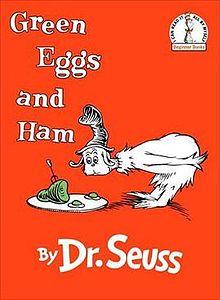Dr. Seuss
Listen to the Recess! Clip
| Author | John Cech |
| Air Date | 3/1/2007 |

Dr. Seuss Transcript
Someone once said that a good writer, whether for children or adults, has one story, which he keeps retelling in various disguised ways; the fantastic writer has two stories; and the genius has three. Shakespeare, for example, could write tragedies, comedies, and histories with equal brilliance. In the world of children’s books, you can count the geniuses on one hand, and one of those in this could would have to be Dr. Seuss, who was born one hundred and one years ago today.
Dr. Seuss, of course, gave us some of our very best nonsense verse — just think of Fox in Socks, Hop on Pop, Farmer Brown can Moo, Can You?, and One Fish Two Fish, Red Fish Blue Fish. He also created a number of our most important moral fables in Horton Hears a Who, The Lorax, How the Grinch Stole Christmas, Yertle the Turtle, and his bold take on the foolishness of war, The Butter Battle Book — that parable about an arms race that begins when two groups of people quarrel over which side of the slice of bread should be buttered.
And, as if these weren’t enough to fill any writer’s bibliography, Seuss also produced a group of fantasies that opened the doors to the inner lives of children. The Cat in the Hat, one of his best-known books, was about what really happens (in a child’s imagination) when mom’s away — it’s quite a mess, but everything gets put back in place (though just barely) before she returns. What kids fantasize about when their parents are out of the picture was a primal situation for Seuss — in fact, it was the subject of his first book, And to Think That I Saw It on Mulberry Street, which was published in 1937. It’s the story of a little boy who can turn the mundane into the extraordinary, all with just a little flexing of his imagination. Seuss had taken the idea to 28 presses before he found the 29th that published it — thus, not only creating one of the first modern American fantasies for young children but also supplying one of those legendary examples of endurance for all struggling writers.
Seuss’s colorful volumes have gone on to sell tens of millions of copies, and one of his books, Green Eggs and Ham has become, according to one source, the third best-selling work of all time in English after the Bible and the works of Shakespeare. Seuss began as an ad man in the 1930s, and he had a real knack for turning our love of jingles into real gold. But more than this, he knew how to sell us on joy and play and fantasy and good, old-fashioned decency.